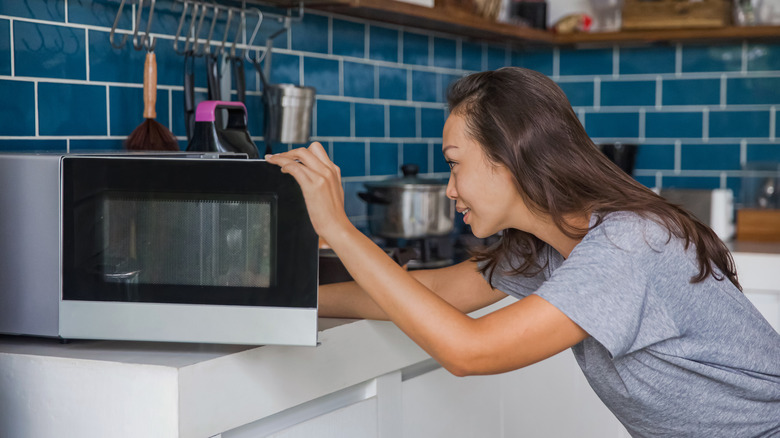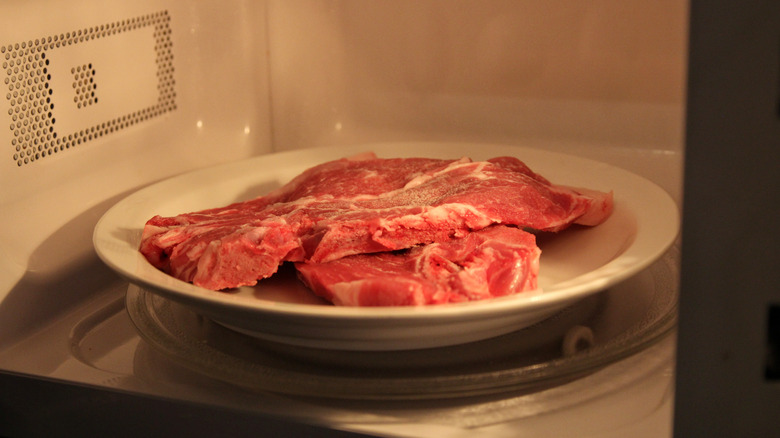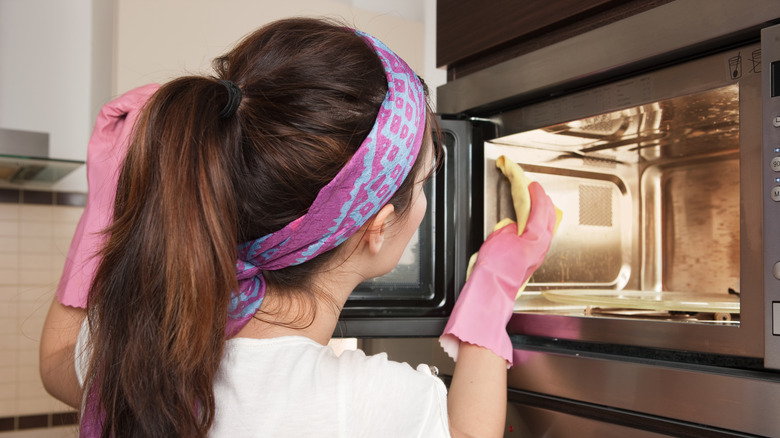The FDA Explains One Risk Of Cooking Food In Your Microwave
Microwaves are a comfortable balance between a stove and a regular oven. You can throw something in there to heat it up quickly and even cook your food in it when you're in a hurry.
But try as you might to use it like your regular oven, microwaves have their own way of working. As explained by Assistant Professor of Chemistry at Birmingham-Southern College in Alabama, Chad Mueller (via Scientific American), "A microwave oven cooks food because the water molecules inside it absorb the microwave radiation, and thereby heat up and heat the surrounding food." This means that food cooks a little differently in a microwave than it does in a traditional oven.
While you can still make microwave rice and steam your broccoli, there is one risk the FDA thinks you should be thinking about — the evenness of cooking. With a microwave, the cooking process isn't your regular "inside out" approach, as explained by the U.S. Food and Drug Administration (FDA). The food actually starts cooking from the outer corners first, after which the "conduction of heat from the hot outer layers" helps cook the rest (via FDA). While bacteria in food can definitely be destroyed with microwave cooking, the key is to check temperature levels at different points of the cooking process and in several areas of your food. To be on the safe side, you may want to keep a food thermometer beside you — especially if you're cooking meat.
How you place your food in the microwave matters
With a conventional oven, placement of food doesn't matter as much as it does with a microwave (that's why you can stick a whole turkey in there and not worry about it too much). But with a microwave, cooking something big may necessitate cutting it into smaller pieces and spreading them evenly in a microwave-safe dish before you place them in the oven. Again, this helps with the evenness of cooking. You could even place chunkier sides of the food toward the outer corners of the dish so that they cook better, per BBC Good Food.
That's not to say that you can't cook a turkey in a microwave (whether you'd want to or not is a different question). As explained by chef and owner of Take it Personal Chef Service, Josh Champion (via Yahoo Life), keeping track of USDA guidelines for poultry temperatures is important. "I mean, you could literally throw an entire turkey in the microwave, and as long as you cooked it long enough in your microwave to cook the center to 165 degrees Fahrenheit [it would be edible]," shared Champion.
Stirring or flipping food over and covering it with a lid (with room for steam to escape) can also help with the risk of uneven cooking. If you're using cling film, puncture some holes on the surface to let the steam get out. Exploding food in the microwave is a real thing.
Some other tips to keep in mind
Another important thing to remember is "standing time." Also referred to as "carryover cooking time" and "resting time," this is the time after which you remove the food from the microwave where the food is still cooking. Take the "standing time" into consideration before, during, and after the cooking process. This may mean you have to wait a while before you dig in.
While cling film is generally safe to use inside a microwave (as long as it's not touching your food), there are other types of plastic that pose a risk, according to Washington State University Professor of Food Engineering, Juming Tang (via BBC Future). "Some plastic isn't designed for microwaves because it has polymers inside to make it soft and flexible, which melt at a lower temperature and may leach out during the microwave process if it goes beyond 100 degrees Celsius (212 degrees Fahrenheit)," he explained.
Cleanliness is another important factor when cooking in a microwave. In fact, this applies to conventional ovens and stoves as well. If you're going to be taking turns making vegetables, meat, and rice in your microwave, clean up between each food type. Avoid overfilling your dish to minimize the mess. At the end of the day, microwaving your kitchen sponge isn't the only cool thing you can do in this type of oven. You can try out various delicious recipes — as long as you understand the appliance you're working with.



